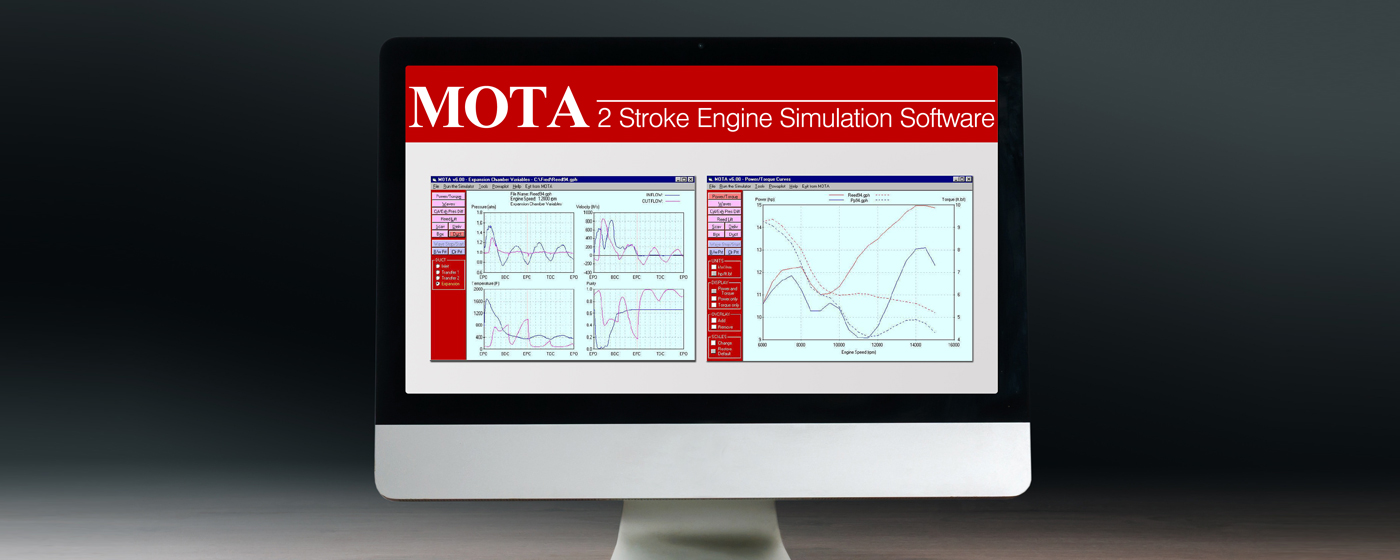
Technical Information
DEFINITIONS of terms used in the MOTA manual, and the outputs produced by MOTA.
TRAPPED SWEPT VOLUME. The total volume above the piston after the exhaust port closes during compression.
CYLINDER CLEARANCE VOLUME. Volume above piston when it is at Top Dead Centre (excluding spark plug hole).
COMPRESSION RATIO. Usually taken in a two-stroke engine as the Trapped Swept Volume divided by the Cylinder Clearance Volume.
SCAVENGING. The process by which the cylinder is filled with fresh charge and the spent charge (or some of it) is exhausted.
DELIVERY RATIO. Mass of fresh charge supplied to the cylinder during scavenging divided by the mass of atmospheric air which would be contained in the swept volume ( not the trapped swept volume ) of the engine.
SCAVENGE RATIO (mass). Mass of fresh charge supplied to the cylinder during scavenging divided by the mass of atmospheric air which would be contained in the entire cylinder volume (ie swept volume + clearance volume). Clearly there is a subtle difference between Delivery Ratio and Scavenge Ratio (mass), some sources equate them.
SCAVENGE RATIO (volume). Replace “mass” in the definition of the mass based quantity by “volume”. Clearly, the volume of the delivered air has to be translated to the temperature and pressure of the cylinder, so this is not an easy quantity to calculate (MOTA does it)
SCAVENGING EFFICIENCY. The mass of air delivered to the cylinder which has been trapped ( ie not passed through from the transfer port to exhaust port during scavenging ), divided by the total mass of gas in the cylinder when the exhaust port closes. The latter is composed of fresh charge, burnt gas and fresh charge from the last cycle.
PURITY. As for scavenging efficiency except that the quantity divided is the total fresh charge ( ie the amount delivered this cycle plus that left over from the last cycle.
TRAPPING EFFICIENCY. The ratio of mass of delivered charge which has been trapped to the total mass of delivered charge. Remember that some of the latter exits the exhaust port before combustion starts, ie during scavenging. This turns out to be approximately equal to the scavenging efficiency divided by the mass based scavenging ratio.
CHARGING EFFICIENCY. The mass of fresh charge trapped in the cylinder during scavenging divided by the mass of atmospheric air which fill the entire cylinder volume when the piston is at Bottom Dead Centre. It is equal to the Trapping Efficiency times the mass based Scavenge Ratio (nearly equal to the Scavenging Efficiency).
BMEP. (Brake Mean Effective Pressure). This quantity, multiplied by the engine’s swept volume and number of revolutions per second, gives the actual power developed by the engine.
PMEP. (Pumping Mean Effective Pressure). This quantity, multiplied by the engine’s swept volume and number of revolutions per second, gives the power required to compress the charge in the crankcase and compress the charge in the cylinder. Aside from friction, work must be done at a rate greater than this power before the engine produces any useful output.
FMEP. (Friction Mean Pressure). This quantity, multiplied by the engine’s swept volume and number of revolutions per second, gives the power required to overcome friction during the engine’s operation. When added to the power required to overcome charge compression, the result represents the power that the engine needs to develop to do any useful work.
IMEP. (Indicated Mean Effective Pressure). BMEP + PMEP + FMEP, when multiplied by the engine’s swept volume and number of revolutions per second, the result is the total power being developed by the charge in the engine. Obviously, the total useful power is this quantity minus that due to the charge compression and friction.
BSFC. (Brake Specific Fuel Consumption). This is the fuel consumption in kg/kw-hours. If the engine has a power output of 5kw, a BSFC of 0.5kg/kw-hour, and runs for 10 hours, it will consume 5 x 0.5 x 10 = 25kg of fuel.
DELIVERY AND EXHAUST FLOW RATIOS. The ratios of gas mass flows to a reference mass flowing through the intake and exhaust ports of an engine during a revolution. The relevant point is that they should be within 2 – 3% of each other. If not, there may be a problem with the simulation.

You must be logged in to post a comment.